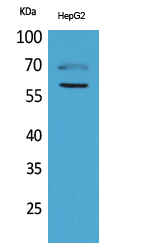HEXA Polyclonal Antibody
- Catalog No.:YT5233
- Applications:WB;IHC;IF;ELISA
- Reactivity:Human;Mouse;Rat
- Target:
- HEXA
- Fields:
- >>Other glycan degradation;>>Various types of N-glycan biosynthesis;>>Amino sugar and nucleotide sugar metabolism;>>Glycosaminoglycan degradation;>>Sphingolipid metabolism;>>Glycosphingolipid biosynthesis - globo and isoglobo series;>>Glycosphingolipid biosynthesis - ganglio series;>>Metabolic pathways;>>Lysosome
- Gene Name:
- HEXA
- Protein Name:
- Beta-hexosaminidase subunit alpha
- Human Gene Id:
- 3073
- Human Swiss Prot No:
- P06865
- Mouse Gene Id:
- 15211
- Mouse Swiss Prot No:
- P29416
- Rat Gene Id:
- 300757
- Rat Swiss Prot No:
- Q641X3
- Immunogen:
- Synthesized peptide derived from HEXA . at AA range: 121-170
- Specificity:
- HEXA Polyclonal Antibody detects endogenous levels of HEXA protein.
- Formulation:
- Liquid in PBS containing 50% glycerol, 0.5% BSA and 0.02% sodium azide.
- Source:
- Polyclonal, Rabbit,IgG
- Dilution:
- WB 1:500 - 1:2000. IHC: 1:100-300 ELISA: 1:20000.. IF 1:50-200
- Purification:
- The antibody was affinity-purified from rabbit antiserum by affinity-chromatography using epitope-specific immunogen.
- Concentration:
- 1 mg/ml
- Storage Stability:
- -15°C to -25°C/1 year(Do not lower than -25°C)
- Other Name:
- HEXA;Beta-hexosaminidase subunit alpha;Beta-N-acetylhexosaminidase subunit alpha;Hexosaminidase subunit A;N-acetyl-beta-glucosaminidase subunit alpha
- Observed Band(KD):
- 60kD
- Background:
- This gene encodes a member of the glycosyl hydrolase 20 family of proteins. The encoded preproprotein is proteolytically processed to generate the alpha subunit of the lysosomal enzyme beta-hexosaminidase. This enzyme, together with the cofactor GM2 activator protein, catalyzes the degradation of the ganglioside GM2, and other molecules containing terminal N-acetyl hexosamines. Mutations in this gene lead to an accumulation of GM2 ganglioside in neurons, the underlying cause of neurodegenerative disorders termed the GM2 gangliosidoses, including Tay-Sachs disease (GM2-gangliosidosis type I). Alternative splicing results in multiple transcript variants, at least one of which encodes a preproprotein that is proteolytically processed. [provided by RefSeq, Jan 2016],
- Function:
- catalytic activity:Hydrolysis of terminal non-reducing N-acetyl-D-hexosamine residues in N-acetyl-beta-D-hexosaminides.,disease:Defects in HEXA are the cause of GM2-gangliosidosis type 1 (GM2G1) [MIM:272800]; also known as Tay-Sachs disease. GM2-gangliosidosis is an autosomal recessive lysosomal storage disease marked by the accumulation of GM2 gangliosides in the neuronal cells. GM2G1 is characterized by GM2 gangliosides accumulation in the absence of HEXA activity, leading to neurodegeneration and, in the infantile form, death in early childhood. GM2G1 has an increased incidence among Ashkenazi Jews and French Canadians in eastern Quebec. It exists in several forms: infantile (most common and most severe), juvenile and adult (late onset).,function:Responsible for the degradation of GM2 gangliosides, and a variety of other molecules containing terminal N-acetyl hexosamines, in the brain
- Subcellular Location:
- Lysosome.
- Expression:
- Brain,Eye,Liver,Ovary,Uterus,
- June 19-2018
- WESTERN IMMUNOBLOTTING PROTOCOL
- June 19-2018
- IMMUNOHISTOCHEMISTRY-PARAFFIN PROTOCOL
- June 19-2018
- IMMUNOFLUORESCENCE PROTOCOL
- September 08-2020
- FLOW-CYTOMEYRT-PROTOCOL
- May 20-2022
- Cell-Based ELISA│解您多样本WB检测之困扰
- July 13-2018
- CELL-BASED-ELISA-PROTOCOL-FOR-ACETYL-PROTEIN
- July 13-2018
- CELL-BASED-ELISA-PROTOCOL-FOR-PHOSPHO-PROTEIN
- July 13-2018
- Antibody-FAQs
- Products Images

- Western Blot analysis of HepG2 cells using HEXA Polyclonal Antibody. Antibody was diluted at 1:1000. Secondary antibody(catalog#:RS0002) was diluted at 1:20000

- Immunohistochemical analysis of paraffin-embedded rat-brain, antibody was diluted at 1:100



